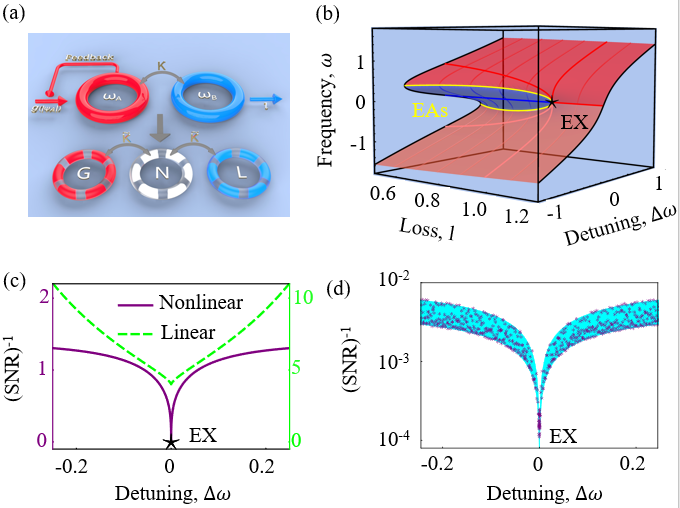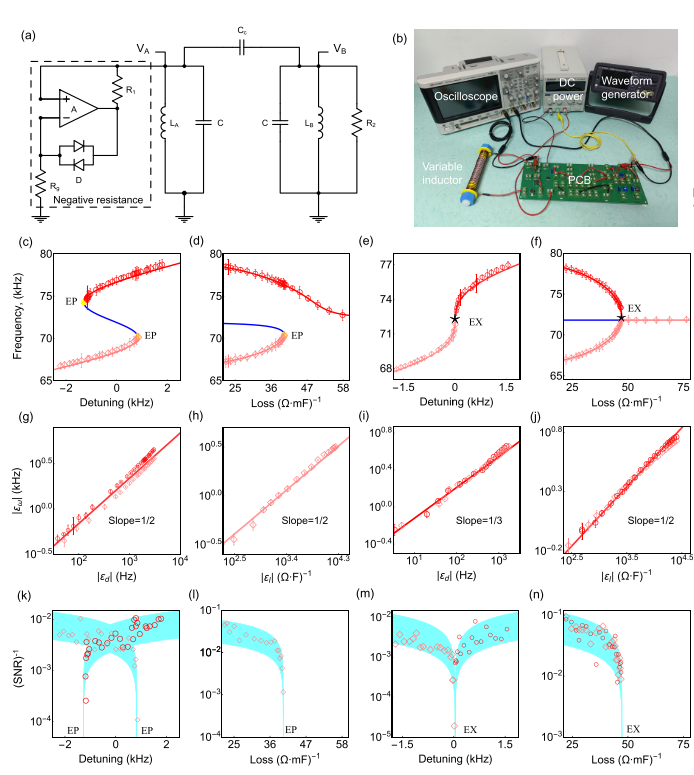Nonlinearity enabled higher-order exceptional singularities with ultra-enhanced signal-to-noise ratio
Our new paper titled “Nonlinearity enabled higher-order exceptional singularities with ultra-enhanced signal-to-noise ratio” is published in National Science Review. This work provides a simple while intuitive example by demonstrating with both theory and circuit experiments an “exceptional nexus” (“EX”), a higher-order exceptional point (HOEP). This HOEP is realized within only two coupled resonators with the aid of nonlinear gain. Moreover, such a HOEP exhibits an ultra-enhanced signal-to-noise ratio.
The recent advances in non-Hermitian physics, such as sensitivity enhancement, skin effects, and mode braiding, are underlain by the exceptional points (EPs). Over the last few years, there has been an ongoing debate about whether EPs can improve the sensor's performance or not. Possible arguments include stringent parameter requirements, fundamental resolution limits, and noise amplification near the EPs. Facing these challenges, researchers intend to conclude that EPs, even higher-order EPs (HOEPs), enhance responsivity instead of signal-to-noise ratio. Here, our result shows that such a nonlinearity enabled HOEP exhibits not only diverging responsivity but also diverging signal-to-noise ratio. Exploring the nonlinear gain saturation in non-Hermitian systems, our work demonstrates with both theory and circuit experiments an exceptional nexus (EX), a HOEP, within only two coupled resonators. Intriguingly, the above-mentioned difficulties encountered for other EPs in sensing can be naturally reconciliated due to the exquisite dimension correlation in this nonlinear system. Moreover, the signal-to-noise ratio is significantly improved in the proximity of HOEP.
This result can have significant instant impacts on the fundamental understanding of the exceptional singularities of nonlinear non-Hermitian systems, and may open new avenues for applications such as ultrasensitive measurements.

(a)The upper panel shows a nonlinear two-coupled-resonators system. The lower panel shows a linear three-coupled-resonators system. (b) Steady-state solution of nonlinear Schrödinger equation. (c) (SNR)-1 from the analysis of stable states. (d) (SNR)-1 from the system dynamics。

(a) Circuit used for experimental verification. (b) Photo of the experimental setup. (c-f) Measured resonance frequencies. (g-j) show the critical behavior near the corresponding EPs and EX in (c-f), respectively. (k-n) show the corresponding (SNR)-1.
For full text:https://doi.org/10.1093/nsr/nwac259






